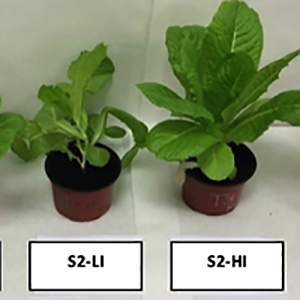High intensity and red enriched LED lights increased the growth of lettuce and endive

Accepted: 28 November 2021
HTML: 142
All claims expressed in this article are solely those of the authors and do not necessarily represent those of their affiliated organizations, or those of the publisher, the editors and the reviewers. Any product that may be evaluated in this article or claim that may be made by its manufacturer is not guaranteed or endorsed by the publisher.
Changes in plant responses have been associated with different fractions of the visible spectrum and light intensity. Advances in light-emitting diodes (LED) have enabled the study of the effect of narrow wavelengths on plant growth and antioxidant compound synthesis. LED technology also facilitates the incorporation of light sources in a controlled setting where light spectra and intensity can be regulated. The objective of this study was to compare the effect of two commercial light spectra (S1: standard white light with 32.8% blue, 42.5% green, 21.7% red, and 2.4% far-red; S2: AP67 spectrum, designed for horticultural growth, with 16.9% blue, 20.5% green, 49.7% red and 12.3% far red) at two light intensities [low intensity (78 μmol m–2s–1 of photons for S1 and 62 μmol m–2s–1 for S2, and high intensity (HI) (102 and 100 μmol m–2s–1 for S1 and S2, respectively)] on growth and antioxidant compound contents in two leafy vegetables: endive (Cichorium endivia L.) and lettuce (Lactuca sativa L.). Fresh weight (FW), dry weight (DW), and DW% of plants were taken as growth indicators. In addition, leaf number, soil plant analysis development index, leaf area (LA), and specific leaf area were also evaluated. Antioxidant synthesis was measured as total phenol content, total flavonoid content, and antioxidant activity. The results showed that S2 and HI increased the FW, DW, and LA in both species. On the other hand, antioxidant compound contents were significantly increased by HI but did not vary with the spectrum.
Highlights
- The spectra of LED affected leaf number in lettuce and endive.
- S2 spectrum improved growth parameters of both leafy vegetables.
- Light intensity improved growth parameters of both leafy vegetables.
- Antioxidant compound contents were significantly increased by high intensity LED light.
How to Cite

This work is licensed under a Creative Commons Attribution-NonCommercial 4.0 International License.
PAGEPress has chosen to apply the Creative Commons Attribution NonCommercial 4.0 International License (CC BY-NC 4.0) to all manuscripts to be published.

 https://doi.org/10.4081/ija.2021.1915
https://doi.org/10.4081/ija.2021.1915







